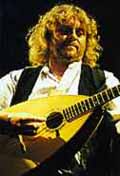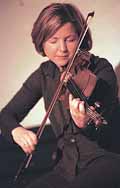 |
||
The Living Tradition
|
|
|||
|
ORAIN FLORAIDH - The
Songs of Flora MacNeil |
|
|||
|
{graphic} |
||||
|
FLORA MacNeil’s second recording of traditional Gaelic song for Temple Records, "Orain Floraidh" (COMD2081), is not only a recording of great emotional depth and subtlety, it is a recording that extends our knowledge and understanding of this most beautiful of musics and, perhaps, its finest living exponent. For the 13 tracks of this set provide ample evidence that, while a substantial proportion of Flora’s repertoire originates in her native Barra, an important element of her work belongs to the neighbouring islands where, in isolation, the song culture of the Southern Hebrides developed along distinctive lines. While for many this distinction may be viewed as an exercise in hair-splitting, the reasons why distinct variations of the ‘same’ songs came to exist within such close localities, is deeply rooted in the history of the people of Barra, Mingulay, Vatersay and Bernaray, Eriskay and South Uist. While reactionary historians (such as The Herald’s Tory convener, Michael Fry) are busy attempting to belittle the nature and extent of events in the 19th and early 20th centuries, that collectively became known as The Clearances, the songs on this CD, their nature and survival within Flora’s family, provide a substantial insight into the traumatic history of the region and how that impacted on people and songs alike. The greatest defence against reactionary historians (who come to prominence, sadly, when their target culture is at its lowest ebb) is the fact that the cultural document exists, passed down through generations, and its lessons cannot be denied. The songs of the Gaelic oral tradition cannot be taken out of the mouths of those that sang the songs and passed them on. The songs cannot be separated from the singers who choose to preserve them, adapt them and value them individually. They had their reasons. For much of the following biographical information I am indebted to the genealogist Cal MacNeil of Kentangavil, Isle of Barra, whose invaluable work and dedication has greatly assisted in unravelling Floraidh’s branch of the MacNeil family tree but, more importantly, Cal has also assisted in unravelling large sections of history geno of Flora’s music – the points and places in time where songs and people may have met and how, as a consequence the songs of long ago, came to accumulate in Floraidh’s repertoire. Further, recordings such as "Orain Floraidh" when read in the broad context of history, may provide some pointers as to the way forward for the ‘tradition’ of Gaelic song. At present this tradition is, in many respects, in healthy condition but anyone close to the singers and musicians who currently sustain the tradition will know that it is riven with difficult and probably destructive disagreements about the soul and sanctity of the music. In an interview conducted in Flora’s home in late 1998, this writer was struck by a very simple- sounding revelation. Flora spoke of how, as a very young child, she was aware that her family were great preservers of the region’s tradition of song. In some regards, Flora can recall being slightly embarrassed at that young age of the ‘old-fashioned’ nature of her family and upbringing – Flora’s feelings were doubtless fuelled by the awkwardness she felt when being encouraged by her primary school teacher to come to the front of the class and sing for her contemporaries. However, curiosity about the origins of these feelings led this writer to Cal MacNeil’s kitchen, a place where the question "does this feeling of Flora’s have any greater significance; could it be an indication that Floraidh’s music is rooted in something deep within the history of her family?" was met with an immediate and unrestrained "yes". There is no better evidence of this than on track 11 of "Orain Floraidh", Floraidh’s beautiful rendition of ‘Seathan, Mac Righ Eireann’ (Seathan, Son of the King of Ireland’). In her sleeve note Floraidh states that she acquired this song from the singing of a cousin of her mother’s, Mary Johnstone, and that Mary sang this as a lament. Floraidh also informs us that in Carmichael’s "Carmina Gadelica", this song is listed as a waulking song. Floraidh sings it as a lament. Tender, intimate, it is a giant of a song that recollects the life joys of one who now mourns. Mary Johnstone, Flora once told this writer, would visit the MacNeil home in Ledag, Castlebay, and join in the informal hearthside singing. But when it came to Mary’s turn to lead on a song, she would be implored by the others present to sing 'Seathan'. It had a special magic - and probably, for Mary, this magic was more than a quality of the melody: it was rooted in the significance of the song and its survival in a culture that had endured the worst forms of adversity. It is not overstating the case to claim that 'Seathan' embodies the emotions and spirit of many who, like Mary’s parents and grandparents, had been forced to live in increasingly marginalised circumstances before leaving Barra to settle on Mingulay. Mary had learnt the song from the oral tradition; those who she picked it up from had similarly learnt it through the oral tradition. The origins of its sorrow and its survival, for it is a very ancient song, must surely, therefore, be rooted in the histories of those that preserved, shaped it and valued it. Mary Johnstone was, as Floraidh identified, a cousin of her mother, Ann Gillies (born in Gearradh Gadhal, 1889). At the time Floraidh heard this song from Mary, it had come full circle. Mary was the daughter of Angus MacNeil, Floraidh’s maternal grandmother’s brother. Mary Johnstone (as she became through marriage) learnt this song during her childhood on Mingulay, where it was sung as a lament. Mary’s grandparents were Neil ‘Beag’ MacNeil (1815-1883) and Catherine MacNeil (1824-1901), neither of whom were originally native to Mingulay but settled there later in life after being moved-on from their original habitation in Barra. Neil ‘Beag’ was born in Gasbhal, Barra, was dispossessed of the family land and moved to the small neighbouring Island of Bernaray, and thence to Mingulay. Catherine MacNeil was born in Borve, Barra. Her passage to Mingulay is unclear, but it is there that she lived with her husband Neil ‘Beag’, and where she had her children. However, while the experiences of Mary’s parents were extreme and insecure, the true picture of marginalisation in this branch of Floraidh’s family comes in the history of repeat moves endured by Mary Johnstone’s paternal grandparents, John MacNeil and Christine Campbell. John MacNeil died in 1818. The first records of his life show that he lived in Tangusdale, an inhospitable and rocky glen above Nask and Castlebay, on the road to Vatersay. Today, ruins of small houses can still be found in this high, remote and barren place. Archaeological records show that settlement of the glen has been sporadic over more than a thousand years. In comparison to the richly fertile pastures of Barra’s West Coast and the machair land of Vatersay, it is poor and unproductive land that would not have provided anything like an adequate living for a family. Unable to survive in Tangusdale, John and Christine MacNeil moved on to Gashabhal and Kinloch. Christine, whose date of birth and death is not known, may have been significantly younger than her husband, or some fate befell him that prematurely ended his life, for at his death in 1818 his son Neil ‘Beag’ was only three years old and with his mother, Christine moved from Mingulay to Berneray. (As stated above, Neil Beag subsequently returned to Mingulay). During her life, Christine lived in Tangusdale, Gasbhal, Kinloch, Mingulay and Berneray - many would say a series of moves to ever more marginal lands. It is from these origins that Mary Johnstone, and subsequently Floraidh, acquired their version of 'Seathan'. Perhaps, the poetry of 'Seathan' was itself particularly meaningful to those whose lives were marred by poverty and insecurity of tenure, as it contains refrains that reflect on memories of better times past: Seathan, Mac Righ Eireann Hu ru o na hi ho ro (chorus) Sgeul is olc le fearaibh Alba Sgeul is ait le luchd an t-sealga Dh’eisd mi ri Aifrionn sa’Chill
Chumha leat
Seathan, Son of the King of Ireland Hu ru o na hi ho ro (chorus) A sad tale to the men of Scotland I and Seathan crossing mountains I heard mass in Cill Chumhe with you (Translation by Donalda MacKinnon, taken from the sleeve notes of "Orain Floraidh") On "Orain Floraidh" there are two songs that Floraidh states came from her Aunt Mary Gillies. Mary, along with Floriadh’s mother Ann, was the daughter of Neil Gillies (1811-1890) and Flora MacNeil (1816 – 1872). They married in 1833 and, like Floraidh’s maternal great grandparents, were resident in Mingulay. The songs contributed to the family’s treasure chest by her great-great-great grandparents (mother’s paternal side) are also of great interest, for this chapter in the family history is also one of great poverty. John MacNeil (1776-1857), Floraidh’s great-great-great grandfather, is recorded as having lived in Tresibhig and Uidh (both Vatersay), and subsequently Mingulay. Standing on the shores of Tresibhig today it is still possible to see where small dwellings once stood and where cultivation of the land took place. Small areas of softer, greener grass can be found, but little else remains. On a sunny day in July it is possible to think of this location as a fine place to contemplate settlement. However, the locality suffers from excessive exposure to the ravages of the Atlantic. For most of the year, those forced to live here would be trying to scavenge an existence in the most arduous of circumstances, the unrelenting gales and stormy seas rendering any attempt at settlement almost impossible. From here John and his wife Mary moved to the equally testing surrounds of Uidh, where in 1816 they had their daughter Flora. From Uidh, the family moved to Mingulay. In this interconnected history of songs and singers, it is interesting to note that the informal ceilidhs that Floraidh so enjoyed as a child were largely the preserve of female members of the family and friends. The maternal link to Mingulay therefore greatly extended the influence of the song tradition of Mingulay and other islands south of Barra in Floraidh’s own repertoire. Of all the songs on "Orain Floraidh" that Floraidh directly connects with family members, not one song is attributed to the paternal side of the family, while Floraidh attributes some songs of the 20th century to male singers. The Paternal side of the family, although resident in Berneray in the 18th century, moved to Barra circa 1830 and remained resident there. However, Floraidh’s family could not have been great bearers of the tradition simply as the result of the influence of the maternal side of the family and, although the paternal family was resident on Barra throughout the Clearances, it is plain that they endured great hardship in the multi-divided crofts on Balanambodach and Brevig on the less fertile, thin soils of the east-side of the Island. It would, of course, be wrong to suggest that only the most melancholy of songs was valid in this sad history. This is simply not the case. However, the variation in songs over time can be attributed to the divergent histories of their singers. Sometimes, as in the case of 'Seathan', the variation is stark and one can only think that Carmichael's version arose from circumstances within the tradition quite distinct from those that shaped the version Floraidh first encountered in the early 1930s. Peter Urpeth |
||||
|
Links, further information and recordings: |



